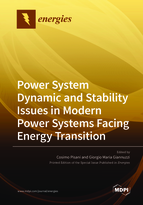Power System Dynamic and Stability Issues in Modern Power Systems Facing Energy Transition
A special issue of Energies (ISSN 1996-1073). This special issue belongs to the section "F1: Electrical Power System".
Deadline for manuscript submissions: closed (20 September 2022) | Viewed by 18777
Special Issue Editors
Interests: dynamic stability of power systems; wide area monitoring and protection systems; high voltage direct current systems; power system restoration
Special Issue Information
Dear Colleagues,
As you probably know, we are experiencing one of the most radical transformations ever experienced in electrical power systems. This process is essentially driven by the establishment of very ambitious energy and climate programs which are based on phasing out coal and increasing the production of electricity from renewable energy sources (RESs). Short circuit power and inertia are hence expected to be reduced more and more in future power systems due to the phasing out of conventional generation and the introduction of power-electronics-based RESs. Overall, the stable operation of the power systems will be consequently affected. Actually, in this transition scenario, power systems are much more prone to experience static and dynamic stability issues that could lead to wide-area blackouts if not properly addressed. Some recent examples around the world confirm the pressing need to address power system stability in a new way with respect to the past. The classic treatment of the stability and control of transmission systems concerns two major areas: steady-state stability and dynamic stability. The steady-state stability of electrical power systems refers to the behavior of a system while operating at any given equilibrium operating point. The main variables to control in maintaining steady-state stability are voltage and current in terms of the load-bearing capacity of transmission lines, transformers, etc. In the world before the sensible energy transition, voltage stability margins were much smaller than the thermal stability ones and consequentially determined the overall stability margins for the power systems. Nevertheless, already today the massive penetration of RES is causing some hours of local congestion bringing certain corridors very close to their thermal rating. On the other side, the dynamic stability of electrical power systems refers to the behavior of the system following any disturbance event, by focusing on the trajectory that it takes from pre-disturbance operating point to post-disturbance operating point. It basically deals with the interactions among the system components. Following a disturbance, the system's variables undergo transients that can induce oscillations in active and reactive power generation, resulting in the appearance of voltage oscillatory modes and frequency deviation in the system. Depending on the entity of the disturbance, small- or large-signal stability of the system under consideration can be investigated. Introduction of RES-based generation that does not participate in the network services (i.e., frequency and voltage regulation) due to lack of special controls undoubtedly affects both the overall frequency and voltage stability. Large-scale transient stability is also a concern not to be overlooked: inverter-based wind and solar generation have a different angle/speed swing behavior with respect to the traditional generation due to reduced inertia, a different voltage swing behavior due to different voltage control systems, different power flow patterns, and displacement of synchronous generation at key locations. Therefore, although power system stability and dynamics have played a very central role in the management and the study of electrical power systems so far, it is also true that the emerging scenario requires new methodologies, technologies, and analyses. In this light, the current Special Issue aims to collect contributions (i.e., research papers and review articles) on power system dynamics and stability from experts in academia and industry.
Dr. Cosimo Pisani
Dr. Giorgio Maria Giannuzzi
Guest Editors
Manuscript Submission Information
Manuscripts should be submitted online at www.mdpi.com by registering and logging in to this website. Once you are registered, click here to go to the submission form. Manuscripts can be submitted until the deadline. All submissions that pass pre-check are peer-reviewed. Accepted papers will be published continuously in the journal (as soon as accepted) and will be listed together on the special issue website. Research articles, review articles as well as short communications are invited. For planned papers, a title and short abstract (about 100 words) can be sent to the Editorial Office for announcement on this website.
Submitted manuscripts should not have been published previously, nor be under consideration for publication elsewhere (except conference proceedings papers). All manuscripts are thoroughly refereed through a single-blind peer-review process. A guide for authors and other relevant information for submission of manuscripts is available on the Instructions for Authors page. Energies is an international peer-reviewed open access semimonthly journal published by MDPI.
Please visit the Instructions for Authors page before submitting a manuscript. The Article Processing Charge (APC) for publication in this open access journal is 2600 CHF (Swiss Francs). Submitted papers should be well formatted and use good English. Authors may use MDPI's English editing service prior to publication or during author revisions.
Keywords
- Power system dynamics
- Power system stability
- Power electronics
- High voltage direct current systems
- Power system stabilizer
- Renewable energy sources
- Wide area monitoring protection and control systems
- Tools and alarms for control rooms
- Inertia
- Synthetic inertia
- Special integrity protection schemes
- System defense plans
- System restoration
- Dynamic security assessment
- SCADA and energy management systems
- Limited energy reservoirs
- Battery energy storage systems
- Synchronous condensers
- STATCOMs
- Dynamic brakings/resistors
- Dispersed generation
- Dynamic models for power system analysis and stability







